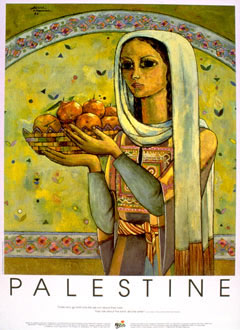Sliman Mansour was born in Birzeit, Jerusalem in 1947, he went to a boarding school in Bethlehem. He is a painter, sculptor, writer and teacher, he played a part in the Liberation Art Movement in Palestine and was one of the New Visions group of Palestinians, he also served as the head of the League of Palestinian Artists from 1986 to 1990 and served as a director of the Al-Waihi Art Centre in Jerusalem, he organised exhibitions from 1990, his work is exhibited in Palestine, Israel, across Europe, Norway and America, he has written two books on Palestinian folklore and in 1998 he won grand prize at the Cairo Biennial. His work is aimed at reminding the Palestinian community of their roots and identity since territory was occupied by Israeli forces. The history of Palestine is far from simple, in the 18th. Century the population of Palestine was 250,000, 6,500 of them were Jews, by 1897 there were three times as many inhabitants, the majority were Gentiles and more than half a million were Arabs.
Mansour started experimenting with mixed media, such as mud, henna, lime on wood and assemblage materials, the idea behind their use was to use home produced materials and boycott paints from Israel. Mansour was working towards giving Palestinians their identity back while still being ruled by Israeli governments, the second intifada saw the death of 3,000 Palestinians and 1,000 Israelis which ended with the PM Ariel Sharon and President Mahmoud Abbas committed to keep the peace in ‘Roadmap for Peace’. Mansour said ‘art helped and is still helping a kind of revival of Palestinian identity. And through art we helped in creating that…. creating symbols for Palestinian identity through art.’
I have chosen a poster, probably painted in water colour of a young Palestinian women called Salma, dated 1978, she wears traditional embroidered clothing, she holds a bowl of oranges, the fruits of the land with her labourer’s hands, the orange tree is a symbol of ‘catastrophe,’ – the occupation of Palestine, more about that later. Mansour is among the intifada group of artists who follow a third way of non – violence, ‘not succumbing to occupation nor getting overwhelmed by hate in confronting the occupation, keeping dignity in everyday life, connecting to the land, culture, religious rights and identity and having respect for the other’s source of identity,’ they were concerned too with Moslem- Christian relations.
Background to the conflict – with reference to a recent review I read in the London Review of Books by Nathan Thrall called My Promised Land; The Triumph and Tragedy of Israel by Ari Savit, the grandson of Herbert Bentwich who in 1897 sailed to Jaffa with a delegation of twenty one Zionists to investigate whether Palestine would make a suitable site for a Jewish national home. Bentwich shut out the fact that non Jews were already living there, he failed to notice the Arabs and Gentiles only planning a Palestinian land for Jews, soon 25,000 mainly secular Jews moved into Palestine and lived in communal agrarian settlements. By 1935 a quarter of the population was Jewish, in 1936 to 1939 there was the Arab Revolt against the British Mandate and Jewish immigration, ethnic conflict had become almost inevitable. In May 1948 Arab armies invaded the territory called Lydda, any rebellion was crushed by the Israeli forces, called the ‘ Catastrophe,’ tensions still exist. The UN idea to divide the land was rejected by the Arabs and fifty six per cent of the land was given to the Jewish population. Sliman Mansour was part of the second intifada working towards a resolution to the conflict. Shavit wrote ‘ that if Zionism was to be then Lydda could not be’ which perhaps condones the actions taken. Although ‘ Ben Gurion was enlightened,’ his wishes to resolve the conflict did not last long.
Mansour painted a series village paintings to remember those inhabitants uprooted in the Jezreel Valley to provide new homes for Israelis. Mansour’s work was often seen as subversive by the Israeli government, he spent time in prison. Art critics see his work as possessing great maturity which shows an awareness of international currents in art. In other posters by Mansour like Salma we see a young woman in traditional dress, often the female image is used for the mobilisation for Palestinian Resistance filled with ‘complex meanings of nation, rootedness, resistance, fecundity and Palestine itself.’ Another poster called The Camel of Heavy Burdens, 1980, the camel depicted is an iconic description of a camel which goes on giving milk in times of drought.
On Youtube there is a clip showing Mansour’s work with music called Baghranni (I sing) sung by Amal Markos.

